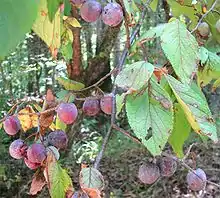Prunus mexicana
Prunus mexicana, commonly known as the Mexican plum,[1] is a North American species of plum tree that can be found in the central United States and Northern Mexico. Its native range stretches from Coahuila and San Luis Potosí north as far as Wisconsin and South Dakota, east to Georgia, Kentucky, and Ohio.[1][3] Mexican plum is widely cultivated, such as on the west coast of the United States.
| Prunus mexicana | |
|---|---|
 | |
| Scientific classification | |
| Kingdom: | Plantae |
| Clade: | Tracheophytes |
| Clade: | Angiosperms |
| Clade: | Eudicots |
| Clade: | Rosids |
| Order: | Rosales |
| Family: | Rosaceae |
| Genus: | Prunus |
| Subgenus: | Prunus subg. Prunus |
| Section: | Prunus sect. Prunocerasus |
| Species: | P. mexicana |
| Binomial name | |
| Prunus mexicana | |
 | |
| Generalized natural range of Prunus mexicana | |
| Synonyms[2] | |
| |
Prunus mexicana is usually found on woodland edges or in open fields. It has a single trunk and reaches a height of 15–38 feet (4.6–11.6 m). It has dark green, simple ovate leaves, fragrant white or pale pink flowers, and dark grey bark banded with horizontal lenticels. Mexican Plums are adaptable to a wide range of soil pH and are drought-tolerant. They are hardy in USDA zones 7 to 9.[4] Early in the spring it is covered with clouds of white fragrant flowers that are up to an inch wide. The dark red or purple fruit ripens late in the fall.[5][6] It is eaten fresh by both animals and humans, the latter also making it into preserves.[7]
Prunus mexicana is very similar to Prunus americana, and they intergrade along a broad contact zone centered around Arkansas and Missouri. These intermediate individuals may be impossible to assign to a specific species.[8]
Prunus mexicana is included in the section Prunocerasus.[9]
Gallery
 Flowers of Prunus mexicana
Flowers of Prunus mexicana
References
- "Prunus mexicana". Germplasm Resources Information Network (GRIN). Agricultural Research Service (ARS), United States Department of Agriculture (USDA). Retrieved 2009-07-21.
- "The Plant List: A Working List of All Plant Species". Retrieved January 27, 2014.
- Biota of North America Program 2014 county distribution map
- Arnold, M. (2002). Landscape Plants for Texas and Environs. Stipes. ISBN 1-58874-153-2.
- "Mexican Plum, Big Tree Plum, Inch Plum". Retrieved April 6, 2014.
- Flora of North America, Prunus mexicana S. Watson, 1882. Mexican or bigtree plum
- Little, Elbert L. (1980). The Audubon Society Field Guide to North American Trees: Eastern Region. New York: Knopf. p. 502. ISBN 0-394-50760-6.
- Flora of North America, Prunus americana
- Shaw, J.; Small, R.L. (2005). "Chloroplast DNA phylogeny and phhylogeography of the North American Plums (Prunus subgenus Prunus section Prunocerasus, Rosaceae)". Am. J. Bot. 92 (12): 2011–30. doi:10.3732/ajb.92.12.2011. JSTOR 4125535. PMID 21646120. S2CID 207658064.
